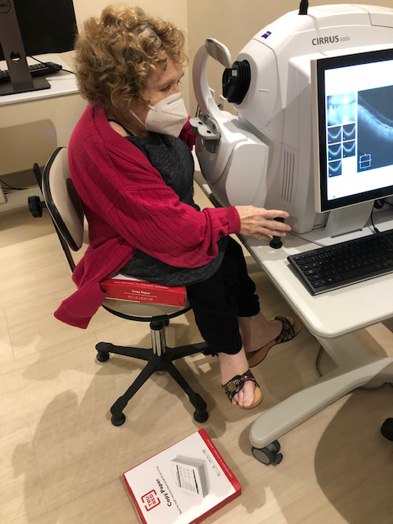
My first post on inaccessible medical equipment was April 19, 2021 before and after cataract surgery. Lamentably, a subsequent diagnosis of a hole in the macular mandated surgery and further access to diagnostic eye equipment. Once again, I was confronted by equipment incompatible with my height of three feet four inches.
Although two reams of copy paper enabled me to mount a chair in front of an eye scanner, I was still short of the chin rest. One imaging technician, citing rules against lifting me, suggested skipping the scan. Too bad that this would leave the surgeon without critical information for diagnostic decisions! Clearly, this was not an option.
Want to subscribe to receive blog updates sign up today!
All I needed was another couple of inches. So I asked the technician to get another ream of paper. She complied because she had no idea what to do. I leaned left raising my right buttock cheek off the seat and had the technician slide the third ream under this side of my butt. After placing my right cheek on the ream, I asked her to push it to the other side of the chair while I scooted my left cheek onto the ream. And voilà, my torso was raised within reach of the chin rest, and the surgeon got his scan.
My annual cardiology check of my Top Hat mechanical aortic valve is also an occasion for confronting access barriers. Although the electrocardiogram (EKG) and echocardiogram equipment are accessible, the examination table is not. The technologist told me that the office did not have an accessible table because it cost $5,000 compared to the $1,500 for a regular table. The accountants won.
As a result, I declined to climb onto the exam table for the EKG and had the test while seated in a chair. The echo was a different story. Although it could be done with me seated, the result would be more accurate if I lay on the table. Here I surrendered my independence and, with assistance, climbed onto a stool then a chair and up to the table.
I’m only one of thousands, possibly millions, of people with disabilities being denied independent access to medical diagnostic equipment (MDE). So where do we go to file a discrimination complaint? The answer is NOWHERE.
Although the Architectural and Transportation Barriers Compliance Board (Access Board) technical criteria for medical diagnostic equipment (MDE Appendix to 36 CFR Part 1195) was due to expire in February 2022, the rule was extended for three years. The Board sought additional time to complete research on low transfer heights. However, the MDE rule remains unenforceable under the Americans with Disabilities Act (ADA) or Rehabilitation Act because it has not been adopted by the United States Departments of Justice (DOJ) and Health and Human Services (HHS).
So instead of filing a complaint, advocate for the Access Board to expedite the research so that accessible MDE can be mandated by enforcement agencies. And share your experiences on inaccessible MDE with Attorney Advisor Wendy Marshall, (202) 272-0043, marshall@access-board.gov.
For further reading, see Standards for Accessible MDE. A Rule by the Access Board. February 3, 2022. https://www.federalregister.gov/documents/2022/02/03/2022-02133/standards-for-accessible-medical-diagnostic-equipment For discussion of diverse disability issues, follow Top 100 Disability Blogs and Websites at https://blog.feedspot.com/disability_blogs/ You can follow my blog on feedspot or at my website, https://angelamuirvanetten.com.

One reply on “Tackling Inaccessible Medical Equipment, Part II”
There are still so many areas that need to be addressed. Thankyou Angela for all that you are doing to enlighten those of us who need to better understand the challenges you face.